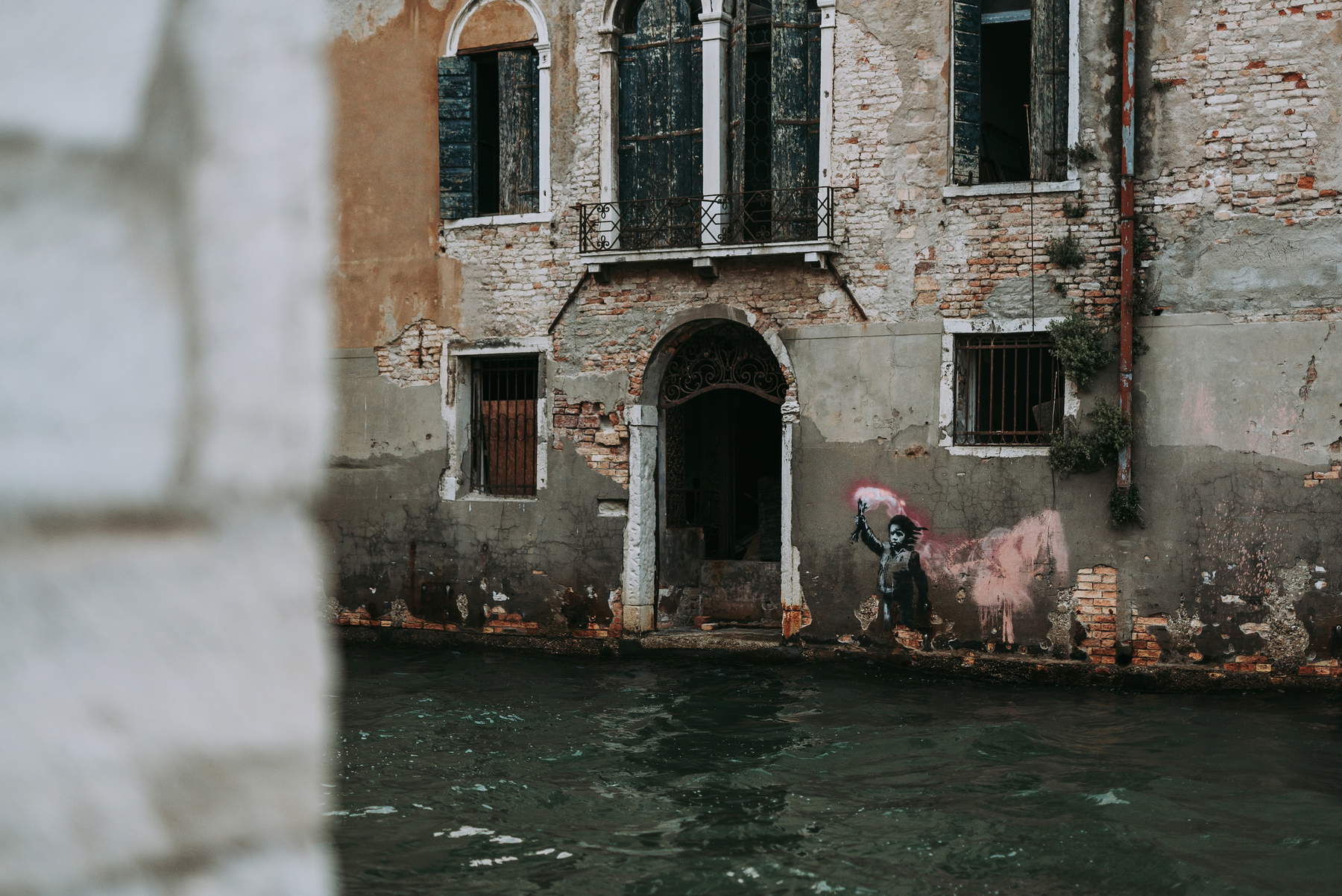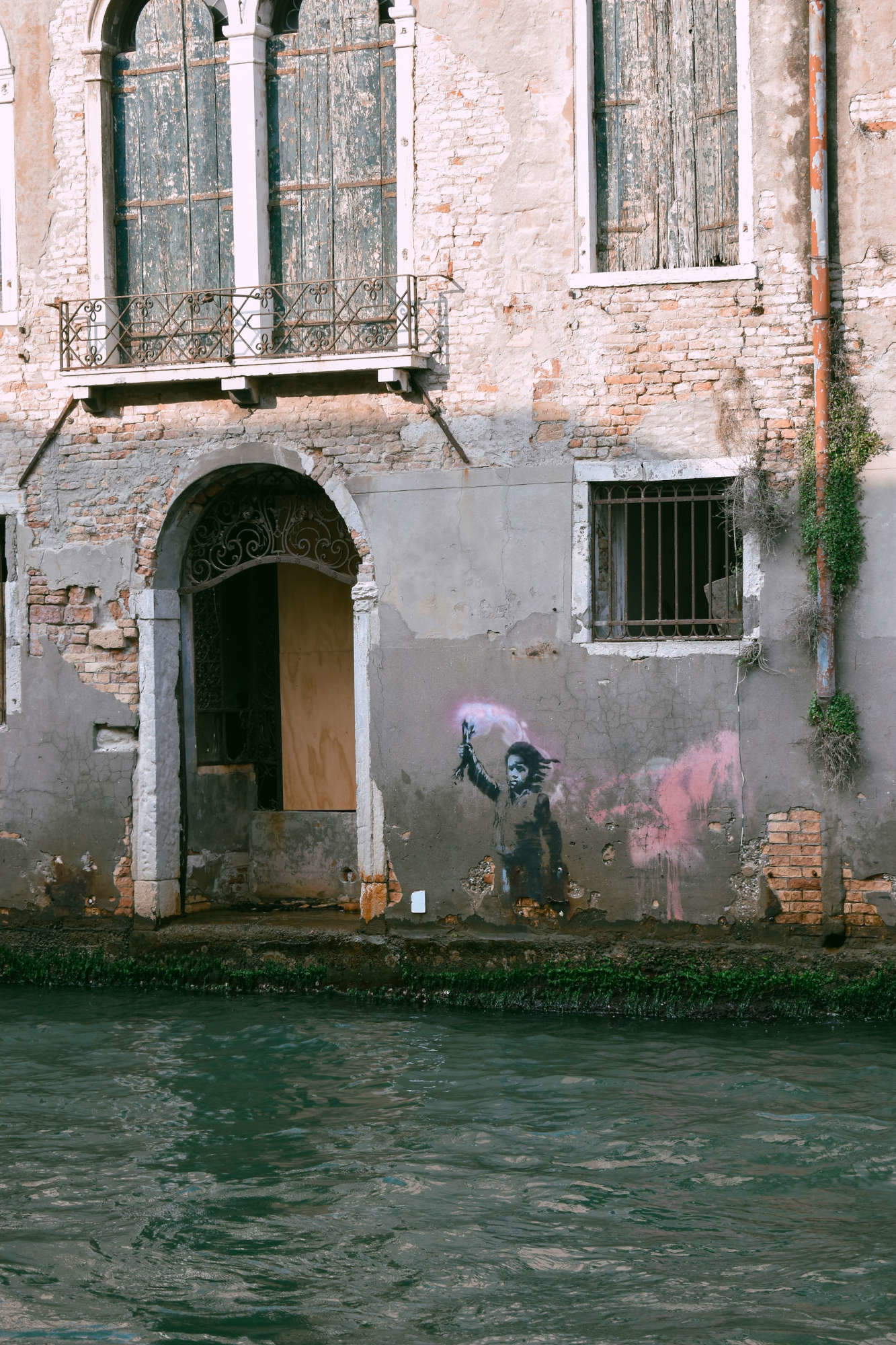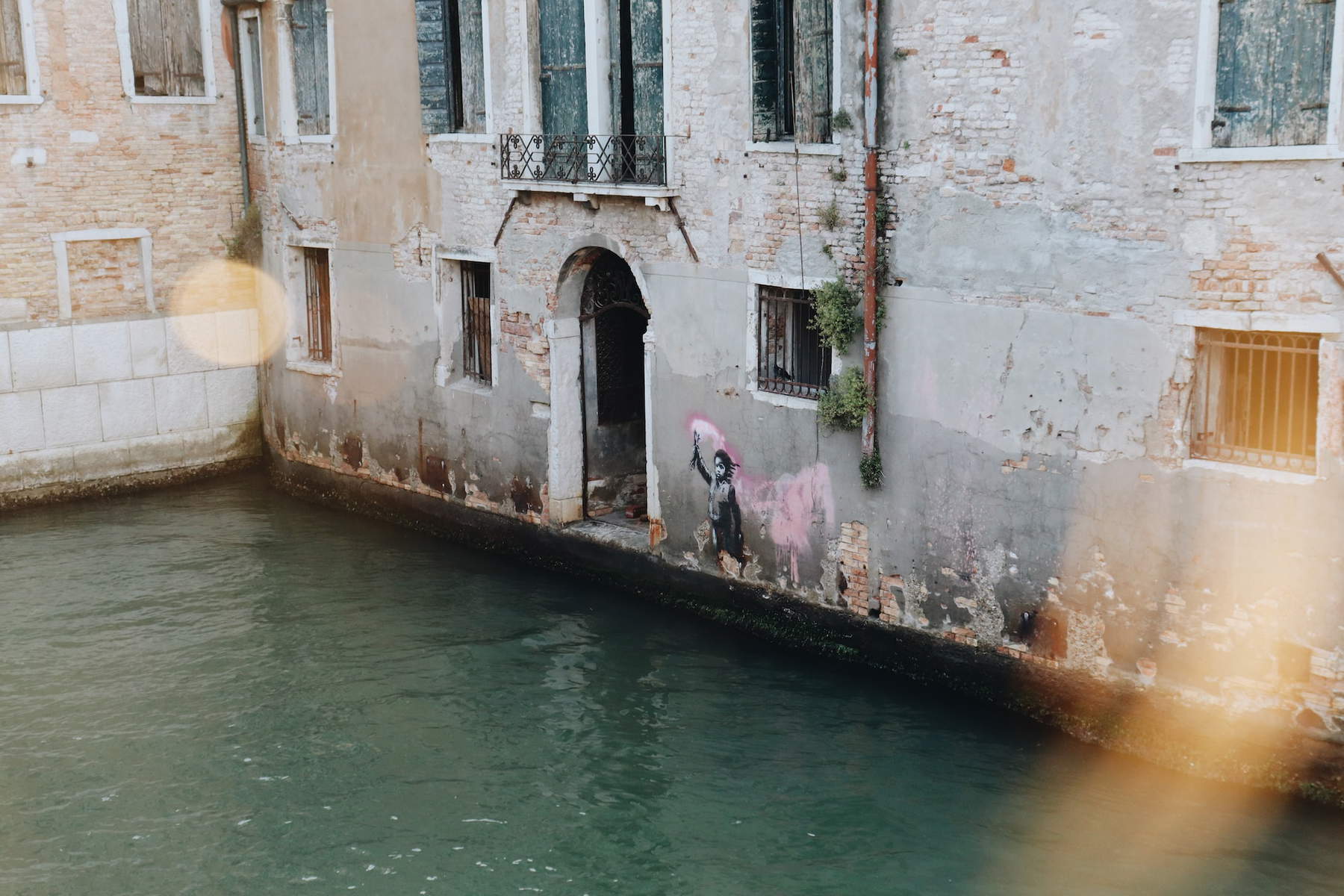The Banksy of Venice will be restored. The case explained well
The Migrant Child (“Migrant child”), Banksy ’s work decorating the facade of a palace in Venice, located near Campo San Pantalon in the Dorsoduro sestiere, overlooking the rio Novo, will finally be restored. Banksy had created the work between May 8 and 9, 2019, confirming the authorship a few days later (to see the work, it is necessary to arrive at Campo San Pantalon and go up on the bridge in front of the church). Financing the restoration project will be Banca Ifis, which today took up the appeal of the undersecretary of Culture, Vittorio Sgarbi, to restore and secure the work: Sgarbi, already a few days ago, had let it be known that he had contacted the bank, whose name was revealed just today.
The project was presented today at a press conference at the Ministry of Culture in Rome, and with this restoration Banca Ifis also intends to strengthen its commitment to art and the territory, already confirmed with the inauguration of the International Sculpture Park at Villa Fürstenberg in Mestre (the Park, which will be open free to the public from spring 2024, brings together the works of ten masters of contemporary art that are displayed in the more than 22 hectares of historically valuable greenery that make up the outdoor spaces of Villa Fürstenberg: artists include Fernando Botero, Annie Morris, Park Eun Sun, Igor Mitoraj, Manolo Valdés, Pablo Atchugarry, Pietro Consagra, Roberto Barni, Julio Larraz, and Philip Colbert). “The conservation and restoration of a public artwork, which is so important worldwide,” said Ernesto Fürstenberg Fassio, president of Banca Ifis, “becomes even more important for the preservation of the communication content that the artist wants to convey through his artwork. Just as Banksy has created a new language that reaches straight to the hearts and minds of children and all of us, with metaphors about the world we live in that are powerful and disorienting, through the expression of this extraordinary art on public land, we have a responsibility in the collaboration between public and private institutions to preserve art and culture in Venice.”

The Migrant Child is one of only two works by Banksy and is deteriorating fromhumidity,high water and salt spray. In the four years since it was created, it has already had loss of detail and color fall off. Thus a lively debate has arisen around whether or not the work should be restored, since the project is divisive: on the one hand there are supporters of the artist’s wishes, who would prefer that the work be left to the elements as it is destined to disappear, while on the other hand there are those who are for preservation and argue that theBanksy’s work, once out of the artist’s hands, would no longer be in his possession (although the copyright issue is actually complex, as will be seen below).
The issue is quite articulate. A summary of the positions of those opposed to the restoration was expressed in recent days by theVenetian Architects’ Association, which expressed its opposition to the restoration project, opposing the argument that the idea behind the graffiti “is that in time it will be submerged by water and will, alas, come to the same end as the many children who have died in the Mediterranean over the last ten years” (so the architects). Banksy’s works “are in fact born to be exposed to the elements, resulting in deterioration and natural destruction,” the architects added. “This is the meaning that also emerges from this work by Banksy, who is a political activist working to awaken the consciences, or perhaps it would be better to say the unconsciences, of the new millennium.” Therefore, those who advocate a position against restoration stress the need to respect the meaning of the work as well as its transience , which is in line with the original message of the Migrant Child.

Today, at a press conference, Undersecretary Sgarbi instead outlined the position of those who support the need for intervention. The discussion also arose from the fact that the Superintendence of Venice cannot take charge of the restoration, since it is the work of a living artist (the law in fact protects only works older than seventy years). In fact, the Cultural Heritage Code assigns to the competent superintendence the protection over works older than seventy years. And this is the case regardless of whether the work, as in this case, decorates the wall of a listed building, the restoration of which therefore falls under the superintendence’s jurisdiction. “That limit of 70 years actually does not put the Superintendency in a position to act directly, much less with public resources,” explained the superintendent of Venice, Fabrizio Magani. “It would be important,” he added, “for an initiative to start for a correction of the Code of Cultural Heritage and Landscape on this particular issue. The paradox is that works like this become cultural heritage only when they are kept inside a public museum.” At the time, moreover, Banksy’s painting was the subject of a complaint by the then superintendent of Venice, Emanuela Carpani, who reported to the Public Prosecutor’s Office what was in fact an illicit act on Banksy’s part, on a par with the vandalism of those who deface the facades of historic buildings: on the part of the Venice Superintendency it was a due act, which in fact ended with thefiling, considered a positive conclusion by both Sgarbi and Magani. Carpani had, moreover, signed a note indicating the interest in the work and thus, implicitly, the need for protection, unrelated to the building’s bond (a bond that, for Sgarbi, becomes a sort of protective element for the work, since the bond “embraces and encompasses the painting”).
According to Undersecretary Sgarbi, the task of the Ministry is to indicate a vision and a direction: in this case, the direction indicated by the undersecretary is that of conservation, despite the fact that the competent superintendency cannot actually intervene. This made it necessary to intercession with a private party willing to take charge of the restoration (which Sgarbi, as anticipated, found: it is Banca IFIS). According to Sgarbi, we are faced with a case of a work illegally carried out on a private building , which, however, is bound as an architectural asset of value, and therefore has a public interest. In cases like these, according to Sgarbi, if the building’s owner decides to restore the painting, it is necessary to assess the fact that we are dealing with a building that has a long and complex history, and with an intervention by a contemporary artist who, in the undersecretary’s opinion, no longer has any connection with a copyright. “Whoever acts abusively on a listed historic building,” Sgarbi said, “cannot expect someone to respect what he has not respected.”

The issue, as mentioned above, gets complicated here: indeed, Magani believes that Banksy can object to the rescue, since it is not a work purchased by the building’s property. Sgarbi, on the other hand, brings the example of the recent graffiti left on the selvage of the Galleria Vittorio Emanuele in Milan, daubed last August by some writers and immediately cleaned up. “We are working on an abusive property, which we can consider erasing,” Sgarbi said, “so the fact is simple: there is no title of resistance, except that of the owners of the house who could say they are not interested in restoration, but even then the Superintendence could impose restoration because the building is dilapidated or has some need.” In this case, however, at least this is a problem that does not arise because the property, represented by lawyer Jacopo Molina, wants to restore the work.
There is then another level of reading: in the collective consciousness, according to those who advocate restoration, Banksy is everyone’s property, and as everyone’s property, according to Sgarbi, the Ministry of Culture has a duty to take care of it, in the sense that it must show attention to that work by having it an obvious interest on the level of historical importance relative to contemporary creativity. The Ministry’s obligation, the undersecretary argues, is to save what can be saved and not to think about the fact that the philosophical or theoretical fate of the work is to be consumed because it was executed with this purpose in mind (“these are issues that concern Banksy’s abusiveness but not our need for protection,” Sgarbi said, adding that “therapeutic overkill is perfectly legitimate if you think about saving something that is in danger of possibly perishing”).
This is also confirmed by Angelo Piero Cappello, director general contemporary creativity of the Ministry of Culture, according to whom the work, having taken on a public dimension, has become part of the system, with the goal of architectural recovery, urban reintegration, and valorization. At this point, then, the preprogrammed perishability of the work is lost, because it is in the interest of the public party to intervene to enhance a public asset, or at any rate to enhance a city area. A more general problem then arises, Cappello said, “Faced with this change in the framework of an artistic expression that we used to call street art sits the role of the General Directorate of Contemporary Creativity, we have to take note that street art as it was born can no longer be called street art: it is an art form like any other, and therefore it has been admitted to legality, it has been sent to support urban recovery projects, it has even been invited to contribute to the enhancement of architectural heritage, and therefore all that context that allowed an artistic expression that arose from an abusive and illegal context to be considered marginal and marginalized, has now disappeared.”
So if on the part of the Ministry the indication is to save Banksy’s work, the question remains as to how the restoration will be done. This is not only a “borderline” case from a legal point of view, but also from a purely technical point of view. Magani called the state of conservation of the building on which Banksy’s mural is located “disastrous.” To date, the Code of Cultural Heritage provides that in certain special situations, as in the case of the work in question, there is an authorization for possible detachment. This, Magani explained, “does not make the graffiti, fresco, plaque or inscription that you want to detach a cultural asset, but from the beginning our administration has provided a certain degree of protection for any detachment operations.” However, in this case, the environmental conditions of Venice (the presence of water, and salts that are also present in the walls of the building), as well as the material conditions of the building, require a technical feat that is unprecedented in the history of detaching a work from a wall, according to the superintendent’s assessments: it is in fact a type of painting that, in addition to being present on a building in a precarious state of preservation, does not involve a classic path when it comes to detachment, although, Magani said, “it is interesting to try.”
For the property, “the desire is to have the asset remain in place, enhancing it as much as possible,” said attorney Molina. “It is a work that we believe goes beyond my assisted company. We believe that interventions like these also bring Venice into the contemporary, ensuring in this case the usability of the asset to all those who pass by in Rio Novo, in Campo San Pantalon, in more peripheral areas of the city that are now being visited by people interested in seeing Banksy.” It is not certain, however, that this will be achieved: doing maintenance on site may be extremely difficult and may not produce the desired results. Positions, at the moment, lean toward detachment, although the operation, as Magani explained, will be far from easy. The mural may then be preserved in a museum (Sgarbi mentioned Ca’ Pesaro in Venice), and could be replaced by a reproduction on the Campo San Pantalon building.
Warning: the translation into English of the original Italian article was created using automatic tools. We undertake to review all articles, but we do not guarantee the total absence of inaccuracies in the translation due to the program. You can find the original by clicking on the ITA button. If you find any mistake,please contact us.




























